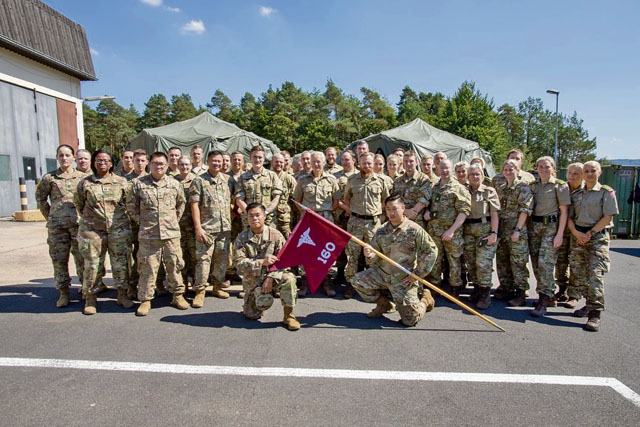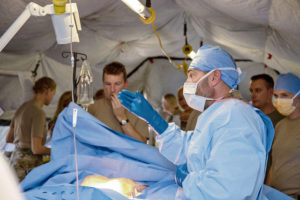
As the sun broke over Rhine Ordnance Barracks Aug. 21, members of the 160th Forward Resuscitative Surgical Team took a short break after establishing their footprint in the early morning hours. A few moments later, a convoy of sleek black vans marked with a simple crown and the phrase ‘Forsvaret’ — Danish Defense — pulled into the compound. Twenty nine members of the Danish Royal Army had arrived to conduct training with Europe’s first FRST, Aug. 21 to 22.
The first day of training began promptly after introductions and welcoming the 29-person Danish surgical team to Rhine Ordnance Barracks. The team was broken down into three groups and each rotated between the three clinical sections of the FRST: advanced trauma life support, the surgical section, and the intensive care unit. Each section showcased equipment imperative to the level of care for which they are responsible.

The ATLS section, which initially resuscitates trauma patients, taught classes on the iStat blood analyzer, the Belmont rapid infusion system, and how to perform a focused assessment with sonography for trauma exam with a portable ultrasound machine. The surgical section laid out instruments found in far-forward war surgery sets, set up an operating suite, and covered anesthesia protocols for complicated surgical procedures. The ICU showed off newly-acquired monitors and ventilators. These machines enable prolonged field care and help ensure that coalition patients are stable enough for transport before being evacuated to a higher level of care.
The Danish medics, doctors, and nurses familiarized themselves with the FRST’s equipment in the afternoon with a hands-on approach. With guidance provided by members of the FRST, they practiced thawing plasma, using the rapid infusion system to resuscitate simulated patients with packed red blood cells, and educated themselves on the proper use of a vital signs monitor. A block of instruction on the joint trauma resuscitation form which documents patient records was also provided. This lesson was particularly important as this form is now the standard for coalition medical teams throughout Operations Enduring Freedom and Inherent Resolve.
The second day focused on roles and responsibilities and patient flow through the trauma system. Members of the 160th FRST worked hand in hand with the Danes discussing scenarios and learning how each team cared for certain types of injuries. After lengthy discussions and equipment education, it was time to test the interoperability of both surgical teams. Trauma scenarios and simulated patients allowed the U.S. and Danish forces to work side by side in a culminating event to ensure world-class surgical care is provided to NATO coalition soldiers anywhere in the world.
Capt. Søren Staunstrup, commander of the Danish Surgical Team, expressed his gratitude for the training opportunity.
“The cultural aspect, both social and professional, greatly contributed to our readiness and ability to work with American Forces,” Staunstrup said. “Seeing the equipment and procedures has definitely helped prepare the team for any future missions.”
Assignments in Europe offer a unique opportunity for service members of all ranks to train and interact with allies and partners of the U.S. Most exercises seen outside of Europe are conducted at a strategic level, however, within Europe, any given Tuesday could present an opportunity to train with U.S. allies.
“This opportunity to train and exchange knowledge with our Danish counterparts helped strengthen relationships with our NATO ally,” said Maj. Chris Angeles, commander of the 160th Forward Resuscitative Surgical Team. “We found that although our languages may differ, our practice was virtually the same and it was easy to work side by side as ‘Soldiers Saving Soldiers.’”


